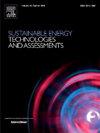Evaluation of wet torrefaction hydrochars as fuel for chemical looping combustion
IF 7.1
2区 工程技术
Q1 ENERGY & FUELS
Sustainable Energy Technologies and Assessments
Pub Date : 2025-02-01
DOI:10.1016/j.seta.2025.104174
引用次数: 0
Abstract
This study evaluated the potential of wet torrefied hydrochars as fuel in chemical looping combustion. Wet torrefaction of empty fruit bunches and oil palm trunks was performed at 180 and 220 °C for durations of 15 to 30 min at the biomass-to-liquid ratio of 1:25. Additionally, the effect of levulinic acid as the catalyst at different concentrations (0.1 and 1.0 M) was investigated to assess the acid catalysed hydrochars’ potential as fuel in chemical looping combustion. Characteristics of the hydrochars were elucidated to provide insights into their physical and chemical properties. The chemical looping combustion was simulated using thermogravimetric-mass spectrometry under oxidative conditions to replicate the fuel reaction phase of chemical looping combustion by oxygen carriers. Wet torrefaction of empty fruit bunches (EFB) and oil palm trunks (OPT) at 180 °C for 15 min without a catalyst produced hydrochars with high energy yields 62.64 % and 63.16 %, respectively. The hydrochars with the higher energy yield and an equal blend of the two were selected for further analysis using thermogravimetric-mass spectrometry. The thermogravimetric-mass spectrometry analysis revealed positive synergistic effects in the hydrochar blend. This could be attributed to the catalytic influence of metal oxides formed from the ash content during oxidative combustion. Wet torrefaction plays a crucial role in removing metals such as potassium (K), which can assist in reducing corrosion and fouling in the reactor.

求助全文
约1分钟内获得全文
求助全文
来源期刊

Sustainable Energy Technologies and Assessments
Energy-Renewable Energy, Sustainability and the Environment
CiteScore
12.70
自引率
12.50%
发文量
1091
期刊介绍:
Encouraging a transition to a sustainable energy future is imperative for our world. Technologies that enable this shift in various sectors like transportation, heating, and power systems are of utmost importance. Sustainable Energy Technologies and Assessments welcomes papers focusing on a range of aspects and levels of technological advancements in energy generation and utilization. The aim is to reduce the negative environmental impact associated with energy production and consumption, spanning from laboratory experiments to real-world applications in the commercial sector.
 求助内容:
求助内容: 应助结果提醒方式:
应助结果提醒方式:


